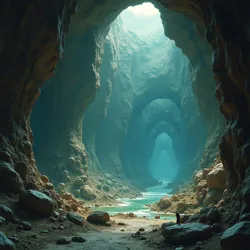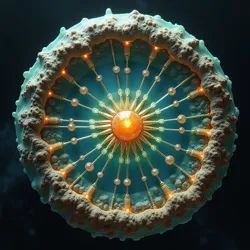Telluric Dynasty
The Telluric Dynasty was a highly advanced subterranean civilization that flourished between 300-150 million years ago, establishing a vast network of engineered caverns and underground cities throughout what is now the Pacific Rim. Distinguished by their mastery of geological engineering and mineral-based technologies, the Dynasty created one of the most extensive and sophisticated pre-glacial civilizations in Earth's history.
 Remnants of Telluric crystalline communication networks discovered in deep geological formations
Remnants of Telluric crystalline communication networks discovered in deep geological formationsOrigins and Physical Nature
The Telluric Dynasty evolved from deep-dwelling lithophagous organisms that developed sentience through their intimate connection with Earth's geological processes. These beings, classified as Petra-sapiens, possessed a silicon-based biology that allowed them to process and manipulate mineral structures at a molecular level. Their physical form was highly adaptable, featuring a crystalline endoskeleton surrounded by dense, metamorphic tissue capable of withstanding extreme pressures and temperatures.
The Dynasty's earliest settlements emerged in natural cavern systems near the boundary between Earth's crust and upper mantle. Their unique biological composition allowed them to survive and thrive in conditions that would be lethal to most other life forms. Through their natural ability to manipulate rock and mineral structures, they gradually expanded these initial habitats into vast underground metropolises connected by an intricate network of tunnels and chambers.
Architectural and Engineering Achievements
The most remarkable achievement of the Telluric Dynasty was their development of Lithomorphic Architecture, a revolutionary approach to underground construction that treated rock masses as malleable, living systems rather than static materials. Using their advanced understanding of geological processes, they could reshape and reinforce rock structures at a molecular level, creating stable void spaces at depths previously thought impossible.
Their cities were masterpieces of geological engineering, featuring vast chambers supported by crystalline matrices that could distribute structural loads across multiple dimensional planes. The Dynasty developed a unique architectural style that incorporated natural geological features into their designs, creating living spaces that grew and evolved alongside their inhabitants. These structures were maintained through a complex system of Mineral Resonance Networks that could detect and prevent structural instabilities before they developed.
Technology and Scientific Understanding
The Telluric Dynasty's technological advancement centered around their mastery of geological and mineral-based systems. They developed Crystalline Computing, a sophisticated method of information processing that utilized precisely grown crystal matrices to store and manipulate data. These crystal computers operated through the manipulation of mineral lattice structures, achieving processing speeds that rivaled modern quantum computers.
Their understanding of geology far surpassed current human knowledge, incorporating what they termed Deep Earth Dynamics - a unified theory of geological processes that allowed them to predict and influence tectonic movements, magma flows, and mineral formation. This knowledge enabled them to create stable habitats at depths where the pressure and temperature would normally make such constructions impossible.
Social Structure and Governance
The Dynasty's social organization reflected the layered nature of their underground realm. Their society was structured into distinct Depth Castes, with different groups specialized for life at various geological levels. The deepest-dwelling castes, known as the Mantle Shapers, were responsible for maintaining the stability of their realm's foundation, while the upper castes managed resources and conducted diplomatic relations with other subterranean species.
Leadership within the Dynasty operated on a principle they called Geological Consensus, where decisions were made through a process that mimicked the gradual formation of crystalline structures. Leaders would emerge naturally through a combination of demonstrated ability and collective agreement, much like how minerals crystallize around seed points in geological processes.
Cultural and Artistic Expressions
Despite their seemingly austere environment, the Telluric Dynasty developed rich cultural traditions centered around the manipulation of minerals and geological processes. Their art forms included Crystalline Harmonics, a unique form of music created by precisely controlled vibrations through crystal formations, and Geological Sculpture, where entire chambers were shaped into complex, evolving artworks that continued to grow and change over centuries.
The Dynasty's language was equally sophisticated, utilizing both acoustic vibrations through rock and crystalline light patterns to convey complex meanings. Their writing system, preserved in certain deep geological formations, consisted of precisely arranged mineral inclusions that could convey information across multiple dimensional planes.
Relationship with Other Species
The Telluric Dynasty maintained complex relationships with other subterranean civilizations, particularly the Mycelial Collective. They established elaborate trading networks through which they exchanged mineral resources and technological knowledge. The Dynasty's deep understanding of geological processes made them valuable allies for other species seeking to establish underground habitats.
Their relationship with surface-dwelling species was more limited, though they occasionally established observation posts in shallow cavern systems to monitor surface activities. The Dynasty maintained a particular interest in the Vapolith Confederation, studying how their atmospheric manipulation technologies affected deep geological processes.
Environmental Management and Resources
The Dynasty developed sophisticated systems for managing their underground environment, including networks of Thermal Regulation Crystals that could control temperature and pressure across vast cavern systems. They mastered the art of cultivating mineral-based food sources and developed methods for recycling and purifying underground water sources through crystalline filtration systems.
 Reconstructed diagram of Telluric thermal regulation crystal networks
Reconstructed diagram of Telluric thermal regulation crystal networksTheir resource management was based on principles of geological sustainability, ensuring that their mining and construction activities did not disrupt Earth's natural processes. They developed methods for accelerating mineral formation and replenishment, creating what modern geologists term Engineered Mineral Cycles.
Decline and Legacy
The gradual decline of the Telluric Dynasty began approximately 150 million years ago, coinciding with significant changes in Earth's crustal dynamics. Rather than facing extinction, evidence suggests that the Dynasty underwent a planned transformation, gradually shifting their civilization deeper into Earth's crust and eventually into the upper mantle. Some researchers propose that they may still exist in these extreme depths, having evolved to survive in even more extreme conditions.
The Dynasty's most visible legacy lies in the vast network of engineered caverns they left behind, many of which remain stable despite millions of years of geological activity. Their advanced understanding of geological processes continues to influence modern scientific thinking, particularly in the fields of seismology and geological engineering.
Modern Discovery and Research
Contemporary study of the Telluric Dynasty has been facilitated by the discovery of their Crystal Archives, vast information storage systems encoded in precisely structured mineral formations. The Deep Earth Archaeological Institute has developed new methods for reading and interpreting these geological records, leading to significant breakthroughs in understanding pre-glacial underground civilizations.
Research into Telluric technology has influenced modern approaches to underground construction and mineral processing. Several research institutions are attempting to replicate their methods of geological manipulation, though with limited success due to the fundamental differences between human and Telluric biological capabilities.
See Also
- Petra-sapiens
- Lithomorphic Architecture
- Deep Earth Dynamics
- Geological Consensus
- Crystal Archives
References
- Journal of Pre-Glacial Studies
- Deep Earth Archaeological Review
- Proceedings of the Geological Sciences Institute
- Archives of Ancient Engineering
- Subterranean Civilization Quarterly